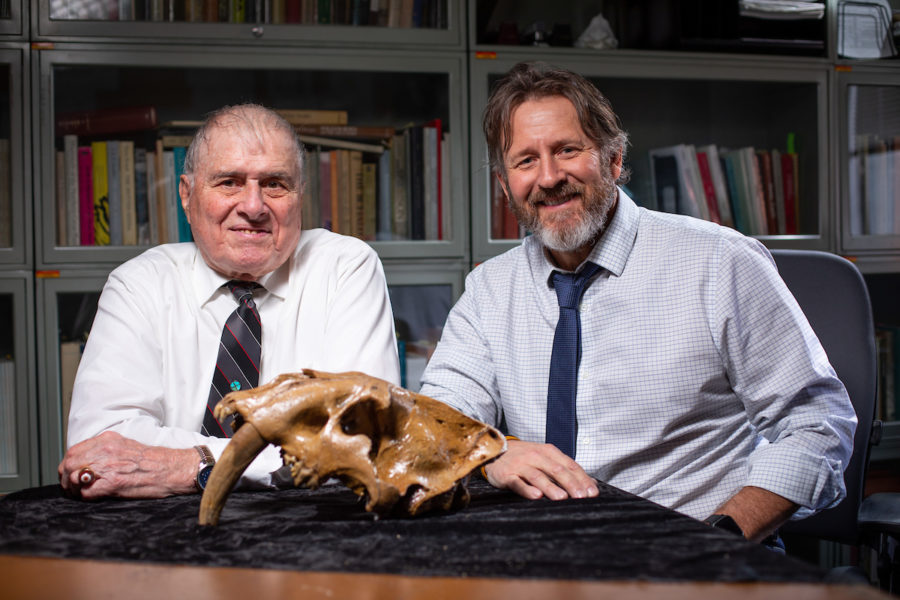‘You are what you eat’: Saber-toothed skull offers insight to Ice Age predator’s behavior
Christopher Gannon/Iowa State University
David Easterla, left, and Matthew Hill, right, with a near-complete skull of a saber-toothed cat found in southwest Iowa.
A 600-pound cat with long sharp teeth in prime physical condition is lying in wait in the bushes for the perfect moment to pounce. Moose, musk oxen and the giant sloth are among its prey.
A near-complete skull of the Smilodon fatalis, more widely known as a saber-toothed cat, was found in southwest Iowa in 2017 and has since been studied by various professionals. It has been radiocarbon dated to be around 13,500 years old, making it one of the last sabertooth cats to walk the Western Hemisphere, according to Matthew Hill, an associate professor of anthropology at Iowa State.
The saber-toothed cat was the “most iconic animal in North America and one of the most iconic in the world,” according to David Easterla, a distinguished emeritus professor of biology at Northwest Missouri State University.

Hill specializes in animal remains from archaeological and paleontological contexts. He said the sabertooth cat was one of the most popular carnivores of the Ice Age and is very rarely found.
“It’s like trying to find a very specific needle in a very large haystack of needles,” Hill said in regard to how rare the species is.
Hill said there are three additional known specimens that are slightly younger; one in Los Angeles and two in South America.
“They’re just little fragments of the animal,” Easterla said. “As far as finding a complete skull in such good condition, wow. It was kind of unexpected.”
This specific cat is estimated to have been about two to three years old when it died. The exact cause of death is uncertain because there are no signs pointing to malnourishment or anything similar.
Hill said a broken canine leads them to believe the cat may have died from a traumatic hunting injury.
There are various ways to guess the age, including the teeth, which are essentially unworn. Hill said the baby teeth had been shed and adult teeth are present but show very little use. An additional piece of evidence that helps estimate the age is the fact that some of the bones that made up the cranium were not fully sealed together, which means they were not fully matured.
Hill said there is a strong chance humans were alive and saw the saber-toothed cat.
“If they didn’t see it, maybe they saw poop,” Hill said. “Maybe they saw, you know, hair. Maybe they saw a kill. That’s really neat to think about.”
Andrew Somerville is an assistant professor of anthropology at Iowa State who specializes in bone chemistry and the archaeology of the Americas. He started working with Hill about a year ago to uncover the diet of the saber-toothed cat.
Somerville said the bones are remarkably well preserved in Iowa. He works in a laboratory on campus and analyzes the collagen within the bones. By doing this, Somerville and Hill can start to understand the ways in which it interacted with other animals, its hunting strategies and its general behavior.
“You are what you eat, and that’s reflected in your bones,” Hill said.
Hill says he feels a great sense of urgency to get everything done and study as much as possible. There is much more he wants to learn and Hill said he gets very excited about it. He appreciates all the public support he has received on his and Easterla’s studies on extinct animals.
“It’s not what we find, it’s what we find out,” Hill said. “So the skull has been found, and it’s what we have learned from this skull that is really important, and we’ll continue to learn from it.”
Your donation will support the student journalists of the Iowa State Daily. Your contribution will allow us to purchase equipment, send our student journalists to conferences and off-set their cost of living so they can continue to do best-in-the-nation work at the Iowa State Daily.















